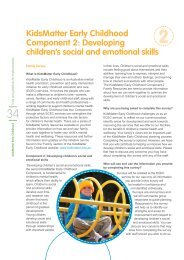Learning to make good decisions and solve problems - KidsMatter
Learning to make good decisions and solve problems - KidsMatter
Learning to make good decisions and solve problems - KidsMatter
You also want an ePaper? Increase the reach of your titles
YUMPU automatically turns print PDFs into web optimized ePapers that Google loves.
Ali <strong>and</strong> Cameron were fighting over a <strong>to</strong>y. A staff member in the earlychildhood service said ‘Let me see if I can help you with the problem.I see that Ali, you <strong>to</strong>ok the <strong>to</strong>y train away from Cameron because youwanted a turn with it, is that right? And Cameron, you wanted <strong>to</strong> keep itbecause you were busy playing with it, <strong>and</strong> you were angry because youhad it first? So the problem is that two people both want the <strong>to</strong>y. Cameronfeels angry <strong>and</strong> hurt because Ali <strong>to</strong>ok the <strong>to</strong>y <strong>and</strong> Ali feels sad because hewants <strong>to</strong> play with it’. As children get older they will be able <strong>to</strong> say howthey feel themselves.Planning <strong>to</strong> <strong>solve</strong> the problemDepending on the age <strong>and</strong> abilities of the children, solutions may be offered (for<strong>to</strong>ddlers) for example, ‘How would it be, Cameron, if you finish your game <strong>and</strong>then give it <strong>to</strong> Ali for a turn?’ If Cameron chooses <strong>to</strong> keep the train for a whileyou could help Ali find something else <strong>to</strong> do while he waits for a turn. (Becausemost <strong>to</strong>ddlers are not really able <strong>to</strong> wait <strong>and</strong> take turns yet, you might also try<strong>to</strong> find another train so they can have one each).If the children are three or older you could say: ‘Can you think of some ways wecould <strong>solve</strong> this?’ If they can’t think of any you could <strong>make</strong> some suggestions forthem <strong>to</strong> choose from. Think of as many options as you can <strong>and</strong> then talk aboutwhat would happen with each one. Even if options seem unworkable, includethem as this encourages children <strong>to</strong> consider different solutions before choosingwhat <strong>to</strong> do next.Remember that often noticing <strong>and</strong> commenting on a child’s emotion is in itselfenough <strong>to</strong> <strong>solve</strong> a problem, for example, Cameron is angry <strong>and</strong> hurt <strong>and</strong> Ali is sad.Doing something about it (action)Staying nearby might be enough support for children <strong>to</strong> try <strong>to</strong> problem <strong>solve</strong>.Sometimes they will need your help. As they get older, children will be able <strong>to</strong>do more problem solving themselves <strong>and</strong> then let you know later how it went.Checking backAsk children about the decision they have made—did it help, did it not help, doyou need <strong>to</strong> find a different way <strong>to</strong> go? This is important because sometimeschildren ask an adult <strong>to</strong> help them with a problem <strong>and</strong> whatever suggestionthey try does not work. If you don’t check back <strong>and</strong> show children how <strong>to</strong> tryagain, they may have lost an opportunity <strong>to</strong> learn or confidence in your ability<strong>to</strong> help.Keep in mind thatevery aspect of achild’s life does nothave <strong>to</strong> be used asan opportunity <strong>to</strong> learnsomething. Havingfun playing their owngames <strong>and</strong> workingout their <strong>problems</strong> isessential <strong>to</strong> healthydevelopment.How decision-makingskills developWhen we are helpingchildren <strong>to</strong> <strong>make</strong><strong>decisions</strong> we need<strong>to</strong> <strong>make</strong> sure ourexpectations fit withwhat they are able<strong>to</strong> do.Often young children cannot decide what <strong>to</strong>do without some help from an adult. Veryyoung children can be given simple choicesbetween two things. Parents <strong>and</strong> carerscan put <strong>problems</strong> in<strong>to</strong> words for the child<strong>and</strong> offer possible solutions. As children ge<strong>to</strong>lder <strong>and</strong> more confident, they are moreable <strong>to</strong> think of ways <strong>to</strong> <strong>solve</strong> their <strong>problems</strong>when they are prompted <strong>and</strong> later can workthem out for themselves without help.2 <strong>Learning</strong> <strong>to</strong> <strong>make</strong> <strong>good</strong> <strong>decisions</strong> <strong>and</strong> <strong>solve</strong> <strong>problems</strong><strong>KidsMatter</strong> Early Childhood – www.kidsmatter.edu.au
Parents, carers <strong>and</strong> early childhood staffcan encourage <strong>to</strong>ddlers <strong>to</strong> <strong>make</strong> their ownchoices <strong>and</strong> may avoid saying ‘No’ morethan they have <strong>to</strong>. A staff member mightsay ‘Yes’ <strong>to</strong> a child who does not want <strong>to</strong>have morning tea at the same time as theother children because he is busy makingsomething. If parents <strong>and</strong> carers do have <strong>to</strong>say ‘No’, it is helpful <strong>to</strong> give a simple reasonthat the child can underst<strong>and</strong>. For example‘No, we can’t blow bubbles inside becauseit will <strong>make</strong> the floor slippery. But let’s blowthem outside’.Offering two choices gives children practiceat feeling confident in choosing. You migh<strong>to</strong>ffer two different shirts <strong>to</strong> wear, twodifferent <strong>to</strong>ys <strong>to</strong> choose from, or a choicebetween a banana or some strawberries.Babies (birth <strong>to</strong> around 18 months)ffRight from the start, babies notice patterns in their lives, such asfamiliar voices, how faces look <strong>and</strong> the patterns of people’s behaviour.ffBabies learn they can have an impact on these patterns (e.g., they learnthat when they smile, someone smiles back <strong>and</strong> when they are vocal,someone talks back).ffBabies need a predictable environment (e.g., if a different personattends <strong>to</strong> them each time they cry, or sometimes people smile at them<strong>and</strong> sometimes they look angry, it <strong>make</strong>s it harder for babies <strong>to</strong> learnhow <strong>to</strong> respond).When you hold out two <strong>to</strong>ys <strong>to</strong> a baby <strong>and</strong> the baby chooses one, the baby ismaking a decision. When you offer babies a feed <strong>and</strong> they turn their head away,they are making a decision.You can help babies develop their decision-making skills by respecting their need<strong>to</strong> choose when they can. For example, if they don’t like a food, you can offerthem something different; if they are upset when you try <strong>to</strong> leave them you couldstay <strong>and</strong> comfort them. This helps babies build a sense of trust <strong>and</strong> confidence.Sometimes adults can let <strong>to</strong>ddlers learnfrom making mistakes with choices, aslong as they are not harmful. For example,a <strong>to</strong>ddler who wants <strong>to</strong> experiment withputting their peas in their milk mightdecide they don’t like it. No harm is done;they have learned something <strong>and</strong> made adecision.It is beneficial for <strong>to</strong>ddlers <strong>to</strong> <strong>make</strong> choiceswherever they can, but when there is anissue of physical or emotional safety, itis important that parents or carers takecharge. One important choice <strong>to</strong> give<strong>to</strong>ddlers is about what <strong>and</strong> how much theyeat. This is part of coping with their newworld. Like adults, <strong>to</strong>ddlers don’t want <strong>to</strong>eat food they don’t like, or <strong>to</strong> eat whenthey are not hungry. Getting in<strong>to</strong> conflictabout foods is likely <strong>to</strong> be upsetting foreveryone. Providing a variety of foods,including some you know the child likes,<strong>and</strong> letting them choose gives them anopportunity <strong>to</strong> <strong>make</strong> a decision on theirown. Providing just a few choices can <strong>make</strong>it easier for children.Toddlers (around 18 months <strong>to</strong> three years)ffReally want <strong>to</strong> <strong>make</strong> their own <strong>decisions</strong> <strong>and</strong> this is a very positivedevelopmental stepffAre learning they are separate individuals, so this is a very importanttime <strong>to</strong> encourage them <strong>to</strong> <strong>make</strong> choicesffOften have difficulty with <strong>to</strong>o many choices because they can’t holdmany options in their thoughts at onceffOften like things <strong>to</strong> be the same <strong>and</strong> do not respond well <strong>to</strong> change.<strong>Learning</strong> <strong>to</strong> <strong>make</strong> <strong>good</strong> <strong>decisions</strong> <strong>and</strong> <strong>solve</strong> <strong>problems</strong>3Information for families <strong>and</strong> early childhood staff Component 2 – Developing children’s social <strong>and</strong> emotional skills
Preschool children (around three <strong>to</strong> five years)ffAre much better able <strong>to</strong> use words for thinking <strong>and</strong> expressing whatthey needffCan tell someone about a problemffCan wait for some time for something they wantffKnow that their minds are separate from others’, that others don’tknow what they are thinking, have a much better memory, <strong>and</strong> a betterunderst<strong>and</strong>ing of time than when they were younger.Preschool children can hold several things in their mind at once, which meansthey can take in<strong>to</strong> account different things when making <strong>decisions</strong>. For example,a three-year-old who asks <strong>to</strong> go <strong>to</strong> a gym class may know that they enjoy thegym, that there will be other children they like there <strong>and</strong> their parent or carerwill be coming back on time <strong>to</strong> pick them up.By the end of the preschool years children have developed many skills that helpthem <strong>to</strong> start making <strong>decisions</strong> on their own. However, their underst<strong>and</strong>ing ofthe world is still limited <strong>and</strong> they still need the support of parents <strong>and</strong> carers.Older preschoolers can often practise problem solving in different ways (e.g.,sort out dogs from cats, sort the small horses from big horses). This experienceis <strong>good</strong> practise for other decision making. Preschoolers can rememberinformation they have been given, can use this <strong>to</strong> think about new situations<strong>and</strong> are more able <strong>to</strong> manage their feelings <strong>and</strong> actions. This helps preschoolaged children <strong>make</strong> more thoughtful choices.Children’s brain development <strong>and</strong> thinking skillsffBabies are born with millions of brain cells <strong>and</strong> the pathways between thecells that get them working are largely made over the first few years of life.ffThe parts of the brain that are used most develop <strong>good</strong> links <strong>and</strong> becomestronger.This means that the early years are the best time <strong>to</strong> promote the skills for learning<strong>and</strong> thinking (but not the only time, as the brain can change throughout life).As children’s brains grow <strong>and</strong> develop, children become more able <strong>to</strong> hold thingsin their mind <strong>and</strong> remember what they have learned. These qualities are crucialfor problem solving <strong>and</strong> decision making.The ability <strong>to</strong> think, reason, manage feelings <strong>and</strong> the way we look at things arenot separate, they are all dependent on each other. For example, a two-yearoldwho w<strong>and</strong>ers away from a staff member may get very angry with the staffmember for not finding him, because he does not yet underst<strong>and</strong> that otherscannot read his mind. He thinks the staff member knows where he is, so when he‘decides’ <strong>to</strong> w<strong>and</strong>er away he thinks people will find him. He gradually learns hismind is separate through maturation <strong>and</strong> through adults giving him opportunities<strong>to</strong> say ‘No’ <strong>and</strong> <strong>make</strong> <strong>decisions</strong> that are separate from theirs.In order <strong>to</strong> <strong>make</strong> <strong>decisions</strong> <strong>and</strong> <strong>solve</strong> <strong>problems</strong> we need <strong>to</strong> be able <strong>to</strong> managefeelings <strong>and</strong> actions appropriately—<strong>to</strong> be the boss of ourselves, <strong>to</strong> underst<strong>and</strong>what we need <strong>to</strong> do, <strong>and</strong> <strong>to</strong> <strong>make</strong> the best choices. This ability depends on:ffbeing able <strong>to</strong> manage feelings <strong>and</strong> impulses <strong>and</strong> actions (called self-regulation)ffbeing able <strong>to</strong> hold several things in mind in order <strong>to</strong> <strong>solve</strong> a problem(dependent on brain development)ffbeing able <strong>to</strong> think about a problem in different ways in order <strong>to</strong> get thebest solution (dependent on brain development, learning <strong>and</strong> practice).Helping children managefeelings <strong>and</strong> actionsIn the early years parents <strong>and</strong> carers canhelp children control their:ffNegative feelings: by helping childrenlearn how <strong>to</strong> express their angerwithout hitting or yelling at someoneffPositive feelings: by helping childrenexpress enthusiasm, without for examplerushing up <strong>and</strong> hugging strangersffActions: by helping children forexample, s<strong>to</strong>p themselves fromsnatching a <strong>to</strong>y from another child orrunning down the street if somethingfrightens themffImpulses: by helping children s<strong>to</strong>pthemselves <strong>and</strong> think before talkingor actingffAttention: by helping children focuson an activity without being quicklydistracted.Babies <strong>and</strong> <strong>to</strong>ddlers are usually activelyhelped <strong>to</strong> develop these skills by theirparents <strong>and</strong> carers. This control is thengradually h<strong>and</strong>ed over <strong>to</strong> children as theylearn <strong>to</strong> manage their feelings <strong>and</strong> actionson their own.These skills develop with practise <strong>and</strong> supportfrom parents, carers <strong>and</strong> early childhoodstaff. For example, a one-year-old may s<strong>to</strong>pthemselves from <strong>to</strong>uching an electric plugwhen a parent or carer is present. However,if the parent or carer is not present theymay be unable <strong>to</strong> s<strong>to</strong>p their desire <strong>to</strong>explore <strong>and</strong> <strong>to</strong>uch the plug, even thoughthey may be saying ‘No! No!’ <strong>to</strong> themselvesat the same time. This example shows thatthe child knows what they are supposed <strong>to</strong>do, but have not yet mastered the control<strong>to</strong> do it. By the time children are three theycan hold in mind two or three thoughts ortasks (e.g., ‘Please get the newspaper fromthe hall <strong>and</strong> take it <strong>to</strong> Mummy’).When children learn <strong>to</strong> manage themselvesin this way they can s<strong>to</strong>p themselves fromdoing something that is not helpful <strong>and</strong>think about other ways <strong>to</strong> do things.Young children benefitby practising decisionmaking.4 <strong>Learning</strong> <strong>to</strong> <strong>make</strong> <strong>good</strong> <strong>decisions</strong> <strong>and</strong> <strong>solve</strong> <strong>problems</strong><strong>KidsMatter</strong> Early Childhood – www.kidsmatter.edu.au
Some choices not <strong>to</strong> offer young childrenThe following examples do not give children an opportunity <strong>to</strong> practise decisionmaking <strong>and</strong> can <strong>make</strong> it difficult for children <strong>to</strong> develop the confidence <strong>and</strong> skillsfor <strong>good</strong> decision making.ffChoices that are <strong>to</strong>o hard for their reasoning abilities. Two-year-oldsdon’t yet have a <strong>good</strong> underst<strong>and</strong>ing of concepts like time <strong>and</strong> space or thatwhen something disappears it may not come back. Sometimes a parent orcarer may say <strong>to</strong> a two-year-old that they can choose <strong>to</strong> keep their dummyor have a special new <strong>to</strong>y. Two-year-olds need their comfort <strong>to</strong>ys, such asdummies, at times of stress or separation from parents <strong>and</strong> carers, <strong>and</strong>they don’t underst<strong>and</strong> that if they give the dummy away, it won’t comeback when they need it. If a child gives away their dummy for a new <strong>to</strong>y,they may be distressed when it is not there at bedtime. This is a time whenchildren don’t yet have the ability <strong>to</strong> <strong>make</strong> the decision because they cannotpredict what it will mean for them.ffChoices between an activity <strong>and</strong> a consequence. A statement suchas ‘Do you want <strong>to</strong> s<strong>to</strong>p throwing that ball in here or do you want me <strong>to</strong>take away your ball?’ is a warning of what the consequence will be if thechild does not obey you, rather than an opportunity for the child <strong>to</strong> <strong>make</strong>a decision. This kind of choice just confuses children. It would be an actualchoice if you said ‘Your ball might break something in here. Do you want <strong>to</strong>play with it outside or would you like <strong>to</strong> have a s<strong>to</strong>ry here with me?’ffStatements that are not choices. Don’t offer a choice if there really is nodecision <strong>to</strong> be made. For example, ‘Do you want <strong>to</strong> come <strong>to</strong> school in the car<strong>to</strong> pick up your big brother?’ is not a choice if the child has <strong>to</strong> come becausethere is no-one <strong>to</strong> care for them at home.When two-year-old Lennie’s mother asked him ’Do you want <strong>to</strong> come <strong>and</strong> haveyour bath now?’ Lennie said ‘No, thank you’. But Lennie did not really have achoice. His mother had decided it was bath time, so asking if he wanted a bathwas not a time <strong>to</strong> practise making his own choices. His mother might have said‘Lennie it is bath time now, would you like <strong>to</strong> bring your duck or your cow <strong>to</strong>have a bath with you?’ Lennie sometimes says ‘Two minutes more’. He does notyet underst<strong>and</strong> what two minutes means but he has heard his mother say it <strong>and</strong>he knows it means a bit more time. If his mother gives him a little more time hewill be learning the beginning of negotiation skills.Offer children choices <strong>to</strong> develop theirreasoning abilities.This resource <strong>and</strong> furtherinformation on thenational <strong>KidsMatter</strong> EarlyChildhood initiative isavailable <strong>to</strong> download atwww.kidsmatter.edu.au.The <strong>KidsMatter</strong> EarlyChildhood team alsowelcomes your feedbackwhich can be submittedthrough the website.The <strong>KidsMatter</strong> Early Childhood information sheets are resources that have been developed in collaboration <strong>and</strong> with funding from the Australian Government Department of Health<strong>and</strong> Ageing. While every care has been taken in preparing this publication, the Commonwealth does not accept liability for any injury or loss or damage arising from the use of, orreliance upon, the content of this publication.<strong>Learning</strong> <strong>to</strong> <strong>make</strong> <strong>good</strong> <strong>decisions</strong> <strong>and</strong> <strong>solve</strong> <strong>problems</strong>5Information for families <strong>and</strong> early childhood staff Component 2 – Developing children’s social <strong>and</strong> emotional skills



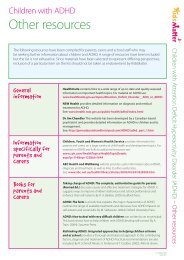
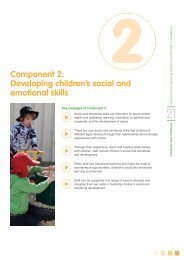
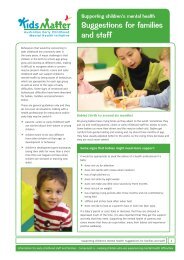
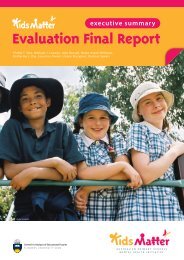

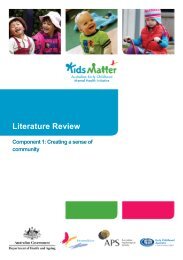
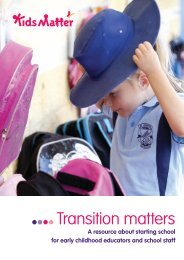
![Trinity Anglican School - Cairns story [378KB]pdf - KidsMatter](https://img.yumpu.com/41716076/1/184x260/trinity-anglican-school-cairns-story-378kbpdf-kidsmatter.jpg?quality=85)
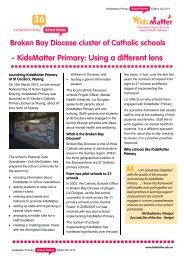
![Happy families work together [327KB] PDF - KidsMatter](https://img.yumpu.com/40767384/1/184x260/happy-families-work-together-327kb-pdf-kidsmatter.jpg?quality=85)
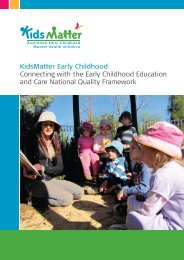
![Action Team Handbook 2012 [1.9M] [PDF] - KidsMatter](https://img.yumpu.com/38050920/1/184x260/action-team-handbook-2012-19m-pdf-kidsmatter.jpg?quality=85)
![[1008KB]pdf - KidsMatter](https://img.yumpu.com/38050895/1/184x260/1008kbpdf-kidsmatter.jpg?quality=85)
